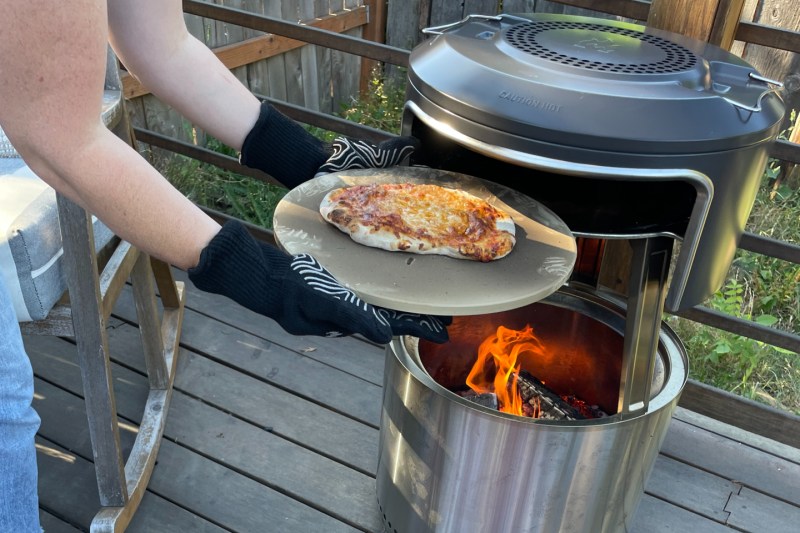
Suffice it to say, we live in the golden age of pizza. There are more styles than ever — from New Haven and Chicago to Hawaiian and even Spokane-style pizza — and restaurants are getting some serious cred for creating new versions of these storied savory pies. On top of all that, it’s easier than ever to make good za at home, thanks to a slew of new outdoor ovens and clever attachments like the Bonfire Pi from Solo Stove.
The new attachment fits directly atop the Solo Stove Bonfire, creating a second-story pizza oven that’s 14 inches in diameter. There are similar attachments for other Bonfire models, such as the Ranger and Yukon. Overall, it’s one of the best outdoor pizza oven options, both in terms of bang for your buck and the attachment’s intuitive nature.

Why we like the Solo Stove Pi
Easy setup
To begin, the Solo Stove Pi could not be much easier to set up. Once the three legs are screed on to the cooking chamber, the attachment is ready to sit above the flames and turn out some pizza. While a bit heavy at nearly 20 pounds, it’s easy to lug around as it comes with handles as well as a bag for transit.
Smart design
The shape is smart, as you get the benefits of a roaring fire — warmth, the hypnotic flames, the ability to roast marshmallows — while the pizza cooks above. In this way, the Bonfire remains a focal point and serves as something people naturally want to gather around. Because you make the fire beforehand, eating the pizza becomes all the more rewarding in the end.
Smoke management
Another unforeseen benefit of the attachment is smoke management. The Pi suppresses smoke and channels it away a bit more than the traditional fire pit, which makes for a more pleasant outdoor hang. We did not experiment with flavors from different kinds of hardwoods, but plan to in the future, as it seems like a fun and decidedly delicious project.
There’s a cleanness to cooking with the attachment that we really liked. The plate wipes down with ease, and there’s not a lot in the way of soot, ash, or other debris related to the fire. The heat is enough to keep most bugs away and because you’re dealing in pizza (finger food enjoyed al fresco, preferably), the whole project leads to a meal with very little cleanup labor.
Tips for cooking pizza with the Bonfire Pi
We had the best luck with thin-crust pizzas and they all turned out well. Going thick is certainly an option, but you’ll want to dial in your temperature beforehand and make sure you have the wood supply to keep the fire fueled. The oven is somewhat shallow, so while you could pull off a Chicago-style pie, you’d probably be pulling it out more often to monitor how it’s cooking (as it would likely be resting too close to the top of the chamber for you to eye it while the pizza is in).
As the brand suggests, it’s key to really warm up the plate before adding the pizza. We made the mistake of not doing so upon our first stab at things and the process was pretty long-winded. Solo Stove suggests getting the plate up to at least 500 degrees F (for this reason, the touchless thermometer is a nice add-on).

Where the attachment can improve
Complaints related to the attachment are pretty few and far between. The plate could be designed better as it can be a little tricky to remove. The plate sits in the oven chamber fairly flush, and we found that we had to sort of pry it out occasionally to check on the pizza. There is a gap right at the front make to fit a finger or two for pulling the plate out, but with gloves on, it can be a tight fit. That would be less of an issue if the plate wasn’t so hot, but even with the gloves donned, removing the plate can be a warm endeavor. Investing in a good peel is a pretty straightforward solution here.
The brand touts the portability of the unit, and while that’s true, moving both the fire pit and pizza oven around is a little cumbersome. We prefer using it in a fixed spot in the yard or packing it in the car to accompany your next camping adventure. Hiking around with the thing on a walk to the park might not be as easy. Again, relatively trivial cons compared to the many pros.

Consensus
If you can make a good fire, you can make a decent pizza. The price ($260) is reasonable, the functionality is solid, and the overall ease of use is impressive. The cooking process is not nearly as fast as that of a higher-browed oven, like something from Ooni, but that’s not a big issue. This is the pizza oven for unhurried backyard gatherings and lazy afternoons. The oven cooks evenly thanks to the ceramic plate and, after making several pizzas, we appreciated the evenness in the crust texture. We endorse the Bonfire Pi for these reasons and more.
Want more pizza-related inspiration? Check out our pizza-making tips from a world champ and our feature on the Roman pinsa style of pizza. Is it dinner time yet?


